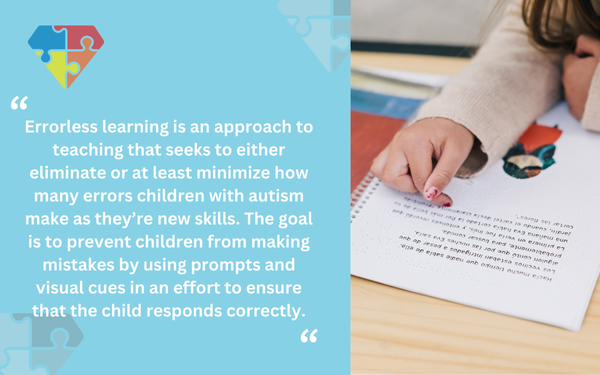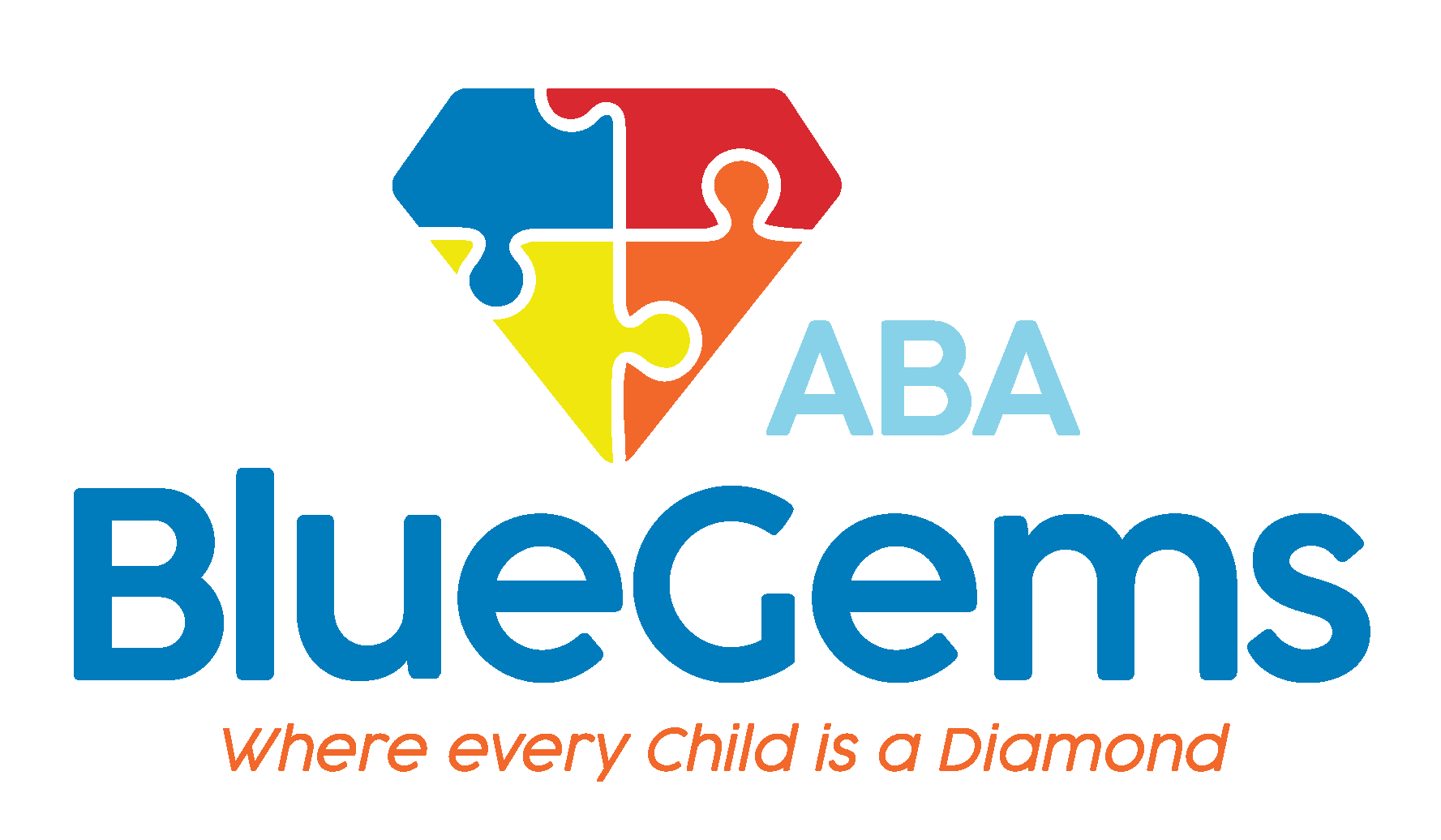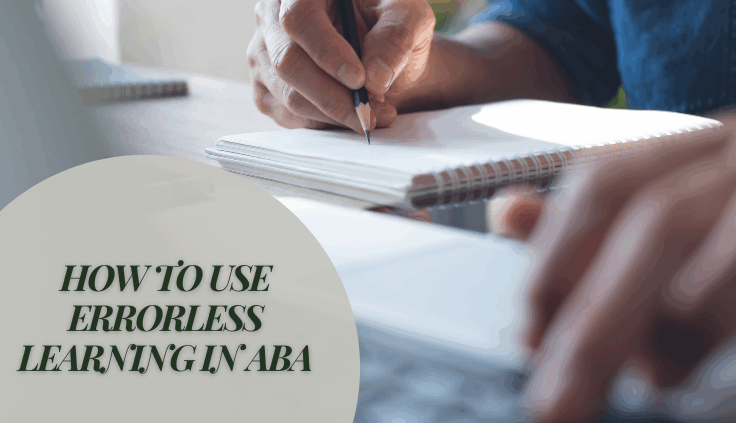Cómo utilizar el aprendizaje sin errores en ABA
Se suele pensar que la gente aprende cometiendo errores. De hecho, entre las técnicas de enseñanza más comunes está la de animar a los niños a probar cosas nuevas, aunque no lo consigan a la primera.
Y es que se cree que cometer errores permite a los niños comprender el proceso que hay detrás de la consecución de objetivos, lo que puede llevar a forjar el carácter, el conocimiento y la comprensión.
Aunque este enfoque de aprender cometiendo errores resulta eficaz para muchos niños neurotípicos, a menudo resulta ineficaz o supone un reto para los niños con trastorno del espectro autista (TEA).
Por ello, el análisis conductual aplicado (terapia ABA) suele seguir el aprendizaje sin errores, un método de instrucción que fomenta el aprendizaje de nuevas habilidades de una forma diferente.
En este artículo analizaremos cómo se utiliza el aprendizaje sin errores en la terapia ABA y por qué es tan eficaz.
Índice
¿Qué es el aprendizaje sin errores?
El aprendizaje sin errores es un enfoque de la enseñanza que pretende eliminar o al menos minimizar el número de errores que cometen los niños con autismo al aprender nuevas habilidades. El objetivo es evitar que los niños cometan errores mediante el uso de indicaciones y señales visuales en un esfuerzo por garantizar que el niño responda correctamente.

Este enfoque suele ser el mejor para los niños con autismo, ya que minimiza la frustración al tiempo que maximiza el éxito. Se basa en la idea de que los niños pueden obtener mejor la orientación y el apoyo que necesitan para poder responder correctamente en distintos escenarios.
Los niños autistas suelen tener dificultades para aprender habilidades porque tienen problemas de procesamiento de la información, memoria y atención. La enseñanza sin errores trata de superar estas dificultades haciendo que los niños respondan con precisión más a menudo, lo que les lleva a recibir un refuerzo positivo en la terapia ABA, que les recompensa por intentar o completar con éxito una habilidad.
A su vez, el niño está más motivado para seguir intentándolo y aprender más.
¿Cómo se utiliza la enseñanza sin errores en la terapia ABA?
La enseñanza sin errores utiliza tres componentes básicos para alcanzar sus objetivos.
La primera consiste en dar pistas. Se trata de pistas o indicios que el terapeuta inicia para indicar al niño que ha llegado el momento de responder.
Las indicaciones pueden ser visuales, verbales o incluso físicas. El objetivo último de las indicaciones es servir de señal para que el niño sepa que ha llegado el momento de realizar la tarea correctamente y sin cometer errores.
El segundo componente es el desvanecimiento del estímulo, que se produce gradualmente a medida que el niño empieza a dominar las habilidades que se le enseñan. Mediante la observación y la recogida y el análisis de datos, los terapeutas pueden determinar cuándo creen que el niño ha adquirido el dominio adecuado de la habilidad.
En ese momento, el terapeuta empezará a desvanecer el estímulo. En otras palabras, reducirá sistemáticamente el apoyo que presta al niño mediante estímulos.
Esto se hace lentamente a lo largo del tiempo, lo que permite al niño demostrar que ha adquirido las nuevas habilidades que se le enseñan de forma independiente.
El último componente del aprendizaje sin errores es el refuerzo positivo, que es un aspecto crucial de todas las estrategias de la terapia ABA. El refuerzo positivo sirve de recompensa para el niño cuando intenta y/o completa con éxito la tarea que se le ha encomendado.
El refuerzo puede adoptar muchas formas, como elogios adicionales, tiempo con un juguete que les guste o una ficha que puedan cambiar más adelante por una recompensa específica. Lo que hace el refuerzo es mejorar las conexiones entre cuál es la respuesta "correcta" y cuál es el resultado deseado por el niño.
Uno de los conceptos básicos de la terapia ABA es que cuando los niños reciben un refuerzo positivo constante, es más probable que respondan correctamente en el futuro.
En última instancia, esto hará que les resulte más fácil generalizar las habilidades aprendidas, lo que significa que serán capaces de responder correctamente en situaciones reales, y no sólo en el entorno estructurado de la terapia ABA.
Blue Gems ABA integra el aprendizaje sin errores en los planes de tratamiento
Aunque cometer errores puede ser una forma eficaz de aprender para los niños neurotípicos, a menudo no lo es para los niños con TEA. Por eso la terapia ABA utiliza el aprendizaje sin errores para adaptar los métodos de enseñanza a su estilo de aprendizaje.
En Blue Gems ABAintegramos el aprendizaje sin errores en nuestros planes de tratamiento de terapia ABA para niños con autismo. Esto les ayuda a desarrollar nuevas habilidades de la forma que más les favorece, en un entorno estructurado y seguro.
Para más información Contacto hoy.




